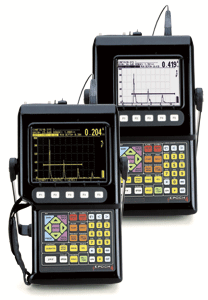EPOCH 4 Ultrasonic Flaw Detectors
 The
EPOCH 4 flaw detector provides a combination of high-quality ultrasonic
performance, simple operation and many documentation capabilities.
The
EPOCH 4 flaw detector provides a combination of high-quality ultrasonic
performance, simple operation and many documentation capabilities.

Download pdf Brochure
(628 kb)
STANDARD FEATURES
-
Customizable narrowband filtering
-
Selectable, tunable square wave or
spike excitation pulser
-
Light, ergonomic design (5.7 lbs/2.6
kg)
-
High-power NiMH battery
-
High resolution ELD or LCD with full
and split screen views
-
Easy, automated transducer
calibration
-
Fast, minimum 60 Hz electronics
update rate
-
Full screen capability of 400 in
(10,000 mm) longitudinal velocity of steel
-
Superior minimum range capability
(0.038 in or 1 mm full scale at longitudinal velocity in steel)
-
Display freeze holds waveform and
soundpath data
-
Soundpath data viewable in units of
inches, millimeters or microseconds
-
Peak hold and peak memory features
-
RF display mode
-
Alarms, threshold positive/negative
or minimum depth
-
Dual gate with echo-to-echo
measurements
-
Security key permits remote upgrade
of software options
SOFTWARE OPTIONS
Optional
GageView Pro Interface Program
The
optional GageView Pro interface program adds many practical editing,
documentation, review and interface capabilities to the EPOCH 4. It helps
manage and format stored inspection data for convenient transfer to and
from other software applications.
Alphanumeric Datalogger
The
EPOCH 4 flaw detector’s sophisticated datalogger is designed for ease of
use while providing a wide range of features for flaw detection and
thickness gaging applications. All saved data can be organized in
alphanumeric file names and identifier codes that can be scrolled and
reviewed on-screen. A memo feature permits entry of additional inspection
data, and the edit feature can be used to add, delete or clear file names
and ID numbers. Available with optional expandable memory.
B-Scan
Generates an easy to understand cross-sectional
profile view of an inspected part. Excellent for corrosion mapping of
pipes, boilers and storage tanks. This view can be used to visually verify
acquired thickness measurements and also highlight areas with critically
thin thickness values.
Download pdf Brochure
(203 kb)
DAC
(Distance Amplitude Correction)
Calculates signal amplitude as a
percentage or dB difference of the DAC curve level (ASME, ASME-3, or JIS).
Same size reflectors peak along the curve independent of their location.
An alarm can be activated when a gated signal breaks the curve.
CSC
(Curved Surface Correction)
Corrects sound path information when
using an angle beam transducer to inspect circumferentially around a
curved surface.
Spotweld
Overlay
Allows on-screen comparison of the live
waveform with a stored reference waveform. The Stamping feature permits
stored weld data to be stamped good, undersized, stick, or two other
operator defined conditions.
Auto-Freeze
Provides the ability to automatically
freeze the A-Scan waveform when a gate alarm has been triggered. The echo
pattern can then be evaluated by the operator and saved if desired.
TVG
(Time Varied Gain) with 40dB Dynamic Range
Corrects for distance/amplitude
variations due to material attenuation and beam spreading. Reference
echoes are brought to a standard full screen level of 80 percent.
Floating
Gate
Automatically varies Gate Level by -6dB
or -12dB of the gated backwall echo. Results in consistency of edge-depth
measurements by making readings at the same relative amplitude.
Interface
Gate
Powerful tool for immersion
applications where the water path distance between the transducer and
front surface of the part is continually changing. Maintains the Interface
Echo (between the water and the front surface of the part) on the left
side of the EPOCH 4’s display.
AWS
D1.1 and D1.5
Provides a dynamic reflector "indication
rating" for various AWS weld inspection applications. This allows for a
more efficient inspection by eliminating manual calculations.
Wave
Analysis
Used to select particular points along
an RF waveform and then obtain a timing/thickness measurement and also a
dB difference between the two points. Applications include measuring the
scale/oxide buildup on the inner diameter of boiler tubes.
DGS/AVG
Flaw sizing technique that permits echo
signals to be evaluated using DGS/AVG diagram associated with a particular
type of probe and material. The DGS/AVG diagram shows the relationship
between echo height, flaw size and distance from the transducer.
Expanded
Memory
Increases datalogger capacity from 500
waveforms/10,000 thickness readings, to 2,000 waveforms/40,000 thickness
readings.
High
PRF (1,000Hz)
Increases the PRF rate of the EPOCH 4
and is useful for higher scanning speed inspections. The high PRF software
fixes the PRF at 1KHz.
Low
PRF (30Hz)
Reduces or eliminates “wrap-around”
noise by setting the PRF to a fixed 30Hz. This feature is often necessary
when inspecting materials that are highly attenuating or have long sound
paths.